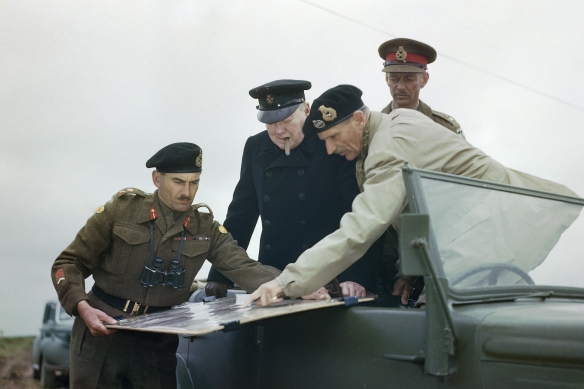
‘Monty had his own opinions on those present [several days prior to D-Day]. Patton he regarded as a sabre-rattler, wilfully ignorant of battle in its administrative dimension, and of army/air co-operation, but still the most aggressive “thruster” in the Allied camp; Bradley he considered dull, conscientious, dependable and loyal . . . ; [Miles] Dempsey [who would lead the British Second Army on D-Day], though he lacked the Guardsman’s ruthlessness and drive of [British Lieutenant-General Oliver] Leese, was cleverer, and he possessed a legendary eye for terrain, ran a high-calibre headquarters and was, behind his quiet manner, completely imperturbable. Only [Henry] Crerar [head of Canadian forces] really worried Monty. . . . Though undoubtedly an efficient headquarters manager, Monty felt grave doubts about Crerar as a battlefield leader, doubts which were to be unhappily confirmed in the months ahead.
It was not, therefore, the most spectacular team of Army Commanders to be leading the largest invasion in history. (From Master of the Battlefield: Monty’s War Years 1942–1944, by Nigel Hamilton.)
(1896–1969), GBE, KCB, DSO, MC
Born in Cheshire of non-military family and educated at Shrewsbury and RMC, Sandhurst, Dempsey was commissioned in the Royal Berkshire Regiment in 1915. First War service was in France where, in addition to being wounded, mentioned in despatches and awarded the MC, he commanded a company at the age of nineteen. Though badly gassed in 1918, he served in operations in Iraq 1919–1920.
Save for his renowned map-reading abilities, Dempsey was an unexceptional regimental officer for most of the inter-war years. A keen sportsman with a pleasant singing voice, he attended the Staff College, Camberley, 1930–1931, served for two years on the staff at the War Office and, in 1938, was placed in command of his regiment’s 1st Battalion. Posted to Palestine he served in 6th Division under Wavell’s command. Sent to France with the BEF at the outset of war, he was appointed to command 13th Infantry Brigade in Franklyn’s 5th Division.
Admitted to the DSO for his part in covering the withdrawal to Dunkirk, Dempsey served as BGS to the 1st Canadian Division 1940–1941. Promoted major general and appointed to command 46th Division he came, once again, into contact with Montgomery who, as his Corps Commander, had him transferred to the newly-formed 42nd Armoured Division in June 1942.
Within six months Dempsey was in North Africa. Montgomery, having ‘demanded’ (Danchev &Todman, 2001, 323) his presence in 8th Army, made him commander of XIII Corps after El Alamein. Thus Dempsey was in the van of the pursuit of the retreating German forces. Though elements of his corps were badly mauled during the assault on the Mareth Line in March 1943, Dempsey was able to enter Tunis in triumph before turning his attention to the invasion of Sicily. In September, it was Dempsey and his XIII Corps that led the invasion of mainland Italy across the Strait of Messina. In the remarkable span of 17 days, Dempsey led his corps some 300 miles up the Italian west coast to link up with Lieutenant General Mark Clark’s Fifth U. S. Army forces at Salerno. Stalled south of Naples XIII Corps did, however, force the crossing of the River Sangro.
Dempsey was called back to London by Montgomery in December 1943 and made commander of the British Second Army. Modest, unassuming, efficient, and quietly competent, Dempsey made a stark contrast with the flamboyant and typically strident Montgomery. Nevertheless, Montgomery recognized talent when he saw it and chose Dempsey to command the Second British Army (which included Canadian and Polish as well as British units) in the Normandy invasion of June 1944. Dempsey landed on Gold, Juno, and Sword beaches on June 6, then advanced inland, capturing Caen on July 9. Dempsey was content to follow orders to batter at the German armored units, tying them down, while the First U. S. Army executed Operation Cobra and broke out of Normandy on July 25. Only then did Dempsey lead his army in battles at Mortain and Falaise, advancing swiftly eastward across northern France and Belgium after these engagements. After this advance, he was assigned a role in Operation Market Garden, Montgomery’s failed and costly attempt in September 1944 to capture Arnhem, Netherlands, as a bridgehead into Germany.
Possessing the ‘charming manners’ of the ‘perfect British officer’ (Pyman, 1971, 68), ‘Bimbo’ Dempsey, the ‘ideal subordinate to Montgomery’, played a subordinate part in the allied advance across North-West Europe. Neither blamed for the failure of MARKET GARDEN nor praised for the Rhine crossing in March 1945, his knighthood was upgraded to KBE.
It was March 1945 before Dempsey finally led the Second British Army across the Rhine. After crossing, he advanced northeastward, taking the major industrial centers of Bremen, Hamburg, and Kiel and reaching the Danish frontier by the end of the war in May 1945 Described as a man who ‘hated publicity’ (Horrocks, 1960, 186), he nevertheless criticized the handling of the American 1st Army in a newspaper interview (Irving, 1981, 245).
The European war over, Brooke, who thought Dempsey suffered from a ‘swollen head’ (Danchev & Todman, 2001, 702), appointed him commander of XIV Army in readiness for the reconquest of Malaya. Succeeding Slim as C-inC Allied Land Forces in South-East Asia, he was promoted General. C-in-C Middle East in 1946, he retired from the army that year. The least flamboyant of Montgomery’s numerous protégés, Dempsey, whether swollen-headed or not, had nonetheless risen highest.
Made Chairman of the Racecourse Betting Control Board in 1947, Dempsey married in 1948. Holding down a number of directorships, he and his wife lived at Yattendon, within easy reach of Newbury racecourse.
Further reading: Badsey, Stephen. Normandy, 1944: Allied Landings and Breakout. London: Osprey, 1990; Ford, Ken, and Peter Dennis. Caen 1944: Montgomery’s Breakout Attempt. London: Osprey, 2004; Ryan, Cornelius. Bridge Too Far: The Classic History of the Greatest Airborne Battle of World War II. New York: Simon & Schuster, 1995.